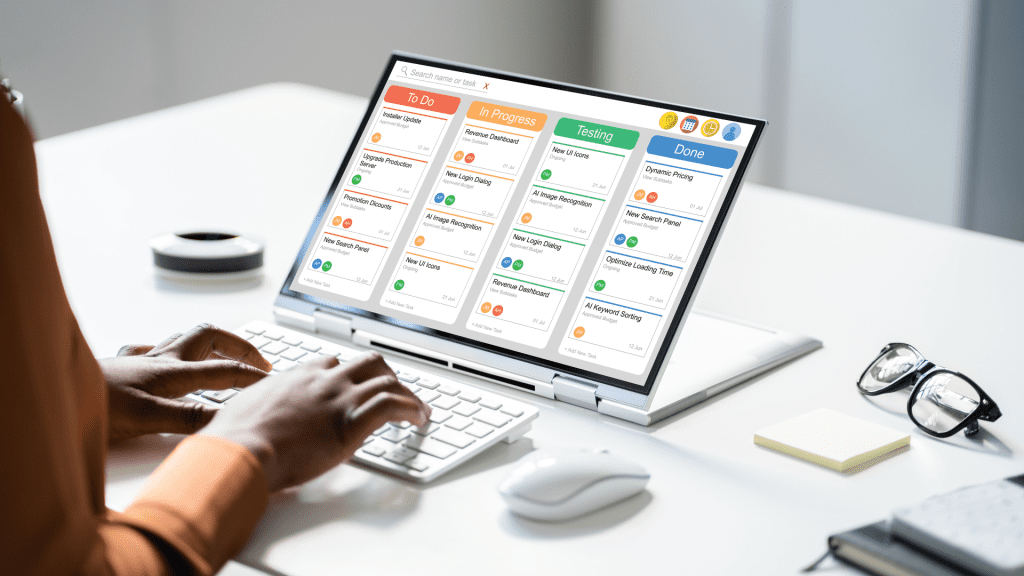Who You Need on Your Software Development Team: 7 Key Positions
Software Development
Read Time: 15 mins

Without the right team structure or adequate staffing, your project is at risk. Nearly 60% of IT projects fail due to poor team composition or mismanagement.
That’s why leadership must recognize the importance of having the right people in place—people who are properly managed, trained, and empowered to drive success. In this article, we’ll walk you through the key roles that make up a high-performing development team and explain why each one matters.
We’ll break down the roles involved, explore the challenges teams face, and highlight what makes a developer the right fit for your specific needs.
How to Build a Software Development Team with the Right Roles
In any IT project, every team member plays a vital part in delivering the best results. While no project is truly perfect, having the right people in place brings you closer to that ideal, ensuring smooth execution and strong metrics. What sets a strong software development team apart is not just technical skills, but the willingness to take ownership and work collaboratively. The most effective teams:- Value each other’s perspectives, expertise, and ideas
- Continuously question and improve their processes and workflows
- Take accountability for their work and how it impacts the broader team
- Foster open communication and collaboration across all functions
Software Development Team Structures and the Role of Team Leads
 Choosing the right software development team structure is a critical factor in achieving efficient workflows and quality results. Whether you opt for a specialist team, a generalist team, or a hybrid team structure, your ability to meet project requirements depends on how clearly roles are defined and coordinated.
Within these structures, the responsibility of a team lead cannot be overstated. A team lead (often a senior software engineer) acts as the glue between developers and managers.
Choosing the right software development team structure is a critical factor in achieving efficient workflows and quality results. Whether you opt for a specialist team, a generalist team, or a hybrid team structure, your ability to meet project requirements depends on how clearly roles are defined and coordinated.
Within these structures, the responsibility of a team lead cannot be overstated. A team lead (often a senior software engineer) acts as the glue between developers and managers.
They mentor software developers, help resolve blockers, and uphold the technical integrity of the software development process. Team leads often collaborate with Scrum Masters in Agile teams to ensure adherence to frameworks like Scrum or Continuous Integration models.
A well-structured team might include front-end developers, back-end developers, and full-stack software engineers. Each contributes to a different layer of a software application.
In a product team structure, these roles are often organized around business goals instead of technical boundaries. This encourages effective communication, faster feedback, and stronger ownership of the final piece of software.
For large projects, a more hierarchical structure may be the best choice. Smaller teams might benefit from flatter structures where frontend developers and backend specialists collaborate directly. In either case, the right structure aligns with the team’s common goals and the capabilities needed for a successful product launch.
Software Development Team: Project Manager vs Product Manager
 In any software development project, it's important to understand the difference between the Project Manager and the Product Manager, two roles that, while closely connected, serve distinct purposes.
A Project Manager is primarily responsible for the execution of the project. They oversee timelines, manage resources, and ensure the team follows best practices to deliver the solution on time and within budget.
Project managers also help coordinate efforts across distributed or hybrid team structures, which are increasingly common in Agile development teams.
Meanwhile, a Product Manager defines the "why" and "what" of a product. They work with stakeholders to set priorities based on business requirements, align the product development team with user needs, and drive long-term strategy. Their input ensures the software solution supports the business model and delivers value to users.
In large or dedicated software development teams, these roles are typically separate, but in smaller projects, a single person may assume both responsibilities.
Regardless of team size, both positions play a crucial role in balancing scope, quality, and delivery speed, especially when using an Agile methodology that demands fast, iterative progress and clear communication.
In any software development project, it's important to understand the difference between the Project Manager and the Product Manager, two roles that, while closely connected, serve distinct purposes.
A Project Manager is primarily responsible for the execution of the project. They oversee timelines, manage resources, and ensure the team follows best practices to deliver the solution on time and within budget.
Project managers also help coordinate efforts across distributed or hybrid team structures, which are increasingly common in Agile development teams.
Meanwhile, a Product Manager defines the "why" and "what" of a product. They work with stakeholders to set priorities based on business requirements, align the product development team with user needs, and drive long-term strategy. Their input ensures the software solution supports the business model and delivers value to users.
In large or dedicated software development teams, these roles are typically separate, but in smaller projects, a single person may assume both responsibilities.
Regardless of team size, both positions play a crucial role in balancing scope, quality, and delivery speed, especially when using an Agile methodology that demands fast, iterative progress and clear communication.
7 Essential Roles in a Software Development Team

Software Development Team: Business Analyst
Business Analysts (BAs) serve as the bridge between business objectives and technical execution. They help shape business goals and define requirements early in the project lifecycle, often even before the full development team is in place. What makes a great BA? It starts with resilience and a vivid imagination. A skilled BA navigates complex processes and shifting priorities with ease, always focused on aligning goals with practical solutions. Adaptability, creativity, and analytical thinking are essential in this role. Since decisions must be grounded in facts, BAs should have a strong grasp of data and the ability to turn insights into action. BAs are especially valuable when the Product Owner can’t fully dedicate time to detailing requirements. In such cases, they take ownership of documentation, ensuring alignment with policies, protocols, and stakeholder expectations. They also bring the development team together to craft strategies that reflect real business needs. Can you do without a BA? Only if someone else on the team has a deep understanding of business processes and the ability to translate them into IT solutions. If you’re fortunate enough to have such a person, invest in their training so they can effectively maintain strong collaboration between end-users and the tech team. This ensures clarity, reduces confusion, and keeps projects moving in the right direction.Software Development Team: Product Owner
The Product Owner (PO) plays a pivotal role in any software development team, acting as the key link between the client’s vision and the end product. They deeply understand the user’s needs and the project’s overall objectives, working to ensure the final solution aligns with both. To succeed in this role, a PO must be adaptable, creative, detail-oriented, and analytical. Their decisions are grounded in continuous business evaluation and awareness of evolving market trends. In fast-moving environments, the PO guides the development team toward meeting goals efficiently and effectively, making their role essential in avoiding project misalignment or failure. Operating within Agile frameworks, Product Owners are used to handling shifting priorities and navigating uncertainty. In some organizations, there may be multiple POs, or the responsibilities may fall to someone like a Chief Marketing Officer, provided they have the right expertise. Ultimately, the PO is focused on maximizing value and driving project success. Their ability to prioritize work based on a clear understanding of business strategy and client expectations is crucial. To keep your project on track and delivering real impact, selecting the right Product Owner is non-negotiable.Software Development Team: Developer
No software development team can function without a developer, they’re the backbone of product creation, responsible for writing the code and bringing ideas to life. Developers are central to delivering high-quality, reliable software. Beyond technical ability, great developers are curious by nature. They stay updated with emerging technologies and constantly seek to improve their skills, often teaching themselves new tools and techniques. Problem-solving is at the heart of what they do. Developers need to break down challenges, think critically, and craft effective solutions. A strong developer also asks insightful questions that move the project forward. They aren’t afraid to push back or propose better alternatives when needed. Another essential trait is the ability to accurately estimate how long tasks will take, helping keep timelines realistic. When hiring, experience isn't always the most important factor. Junior developers with a strong desire to learn, positive energy, and adaptability can add real value, especially on projects that benefit from fresh thinking and flexibility. Senior developers, by contrast, bring confidence, broader experience across diverse systems, stronger estimation skills, and familiarity with agile workflows and various tools. The ideal team combines both new and seasoned developers. This mix creates a collaborative environment where strengths are shared and gaps are filled. Both groups learn from one another, enhancing the team’s overall performance.Software Development Team: Quality Assurance Engineer
A Quality Assurance (QA) Engineer plays a critical role in ensuring that a software solution aligns with its intended specifications and maintains a high standard of quality. They help maintain a high standard of quality throughout the development process. Their work revolves around creating thorough documentation, planning structured test cases, and delivering timely feedback to steer development in the right direction. The responsibilities of a QA Engineer include prioritizing and estimating test efforts, designing and coordinating testing strategies, and defining quality standards and procedures. They also work to ensure client expectations are clearly understood and met throughout the development process. However, in some cases, clients may prioritize speed and budget over thorough testing, viewing QA as optional rather than essential. This mindset can be costly in the long run. A strong QA presence ensures the product is stable and reliable from the start, reducing the need for expensive fixes later in development. Ultimately, quality is a shared responsibility, every team member contributes to the overall success of a product. Still, dedicated QA specialists are essential when delivering a dependable, well-tested solution is non-negotiable. Their role not only enhances product stability and user satisfaction but also protects the development process from inefficiencies caused by undetected flaws.Software Development Team: User Experience (UX) Designer
A User Experience (UX) Designer is responsible for shaping how users feel when they interact with a product. Their ultimate goal is to ensure a smooth, satisfying experience by understanding user behavior, needs, and expectations. To do this effectively, a UX designer must be empathetic, insightful, and equipped with methods to evaluate whether their designs truly serve the target audience. An exceptional UX designer is detail-oriented and quick to identify and resolve usability issues. Their creativity helps them solve problems from multiple angles while aligning their solutions with broader business goals. Rather than relying on gut feelings, their decisions are rooted in thorough research and user testing. Experienced UX professionals bring a strong foundation of ethical design practices, refined processes, and a solid command of tools used to test and improve user interaction. Skipping a UX designer can be risky if your product depends on intuitive usability and user satisfaction. While some argue that developers can handle UX tasks, having a dedicated UX expert provides deeper insight and sharper focus on user needs. Developers and UX designers bring different strengths to the table, together, they create better results. Their collaboration ensures that both functionality and usability are prioritized, resulting in a well-rounded and user-friendly final product.Software Development Team: User Interface (UI) Designer
A UI (User Interface) Designer focuses on predicting how users will interact with a product. They design interfaces that are intuitive, visually appealing, and aligned with user expectations. Their role revolves around making every element of the interface easy to use and understand. They do this by combining visual design, user interaction, and information layout into a cohesive experience.
When you're creating a custom interface, a UI designer becomes essential. They bring ideas to life through sketches, wireframes, and prototypes—regardless of the tools they use—and help shape the product’s look and feel.
Strong communication skills are also a must. A UI designer must clearly convey design concepts to developers, often using visual aids or documentation like user guides to show—not just tell—how a design should function. A skilled UI designer also understands UX principles and integrates them into the product’s visual elements.
A well-designed interface not only makes a product more attractive but also enhances usability. When users can effortlessly navigate an app or platform and achieve their goals without confusion, their overall satisfaction—and the product’s success—improves significantly.
Software Development Team: Software Architect
A Software Architect is responsible for making critical design decisions that shape the overall structure of a system, especially when it comes to non-functional requirements. They define coding standards, choose appropriate tools and platforms, and review code to maintain clarity and reduce unnecessary complexity. An ideal Software Architect is a well-rounded professional who blends deep technical expertise with strong communication, leadership, and even a touch of psychology. They understand how to guide teams, manage expectations, and stay mindful of budgets. Above all, they take full ownership of the technical vision, supporting the project from its inception through development, release, and future improvements. This role becomes essential when your project involves complex non-functional requirements or significant architectural changes. A good Software Architect lays the foundation for scalable, maintainable solutions by defining how a system should function and evolve. Their work also enables the reuse of successful architecture patterns in future projects. For industries like fintech or banking, where secure and reliable systems are non-negotiable, having a strong software architecture is vital. That’s why experienced architects are a core part of high-end development teams in these sectors.Building the Right Team for Software Success
 Creating a successful software product takes more than just great code, it requires a carefully structured team of professionals, each bringing unique expertise to the table.
Creating a successful software product takes more than just great code, it requires a carefully structured team of professionals, each bringing unique expertise to the table.
From setting the technical vision to ensuring a seamless user experience, every role in a development team plays a vital part in turning an idea into a fully functional, high-quality solution.
When these roles are filled with the right people—those who communicate well, take responsibility, and strive for continuous improvement—the chances of project success increase dramatically.
If you're looking to build or scale your development team with skilled developers, QA engineers, UX/UI designers, or other IT specialists, ParallelStaff can help.
Our network of experienced nearshore professionals is ready to integrate seamlessly with your team. We ensure you have the right talent to bring your project to life—on time and on budget. Let ParallelStaff be your partner in assembling a high-performing software development team that delivers real results.
